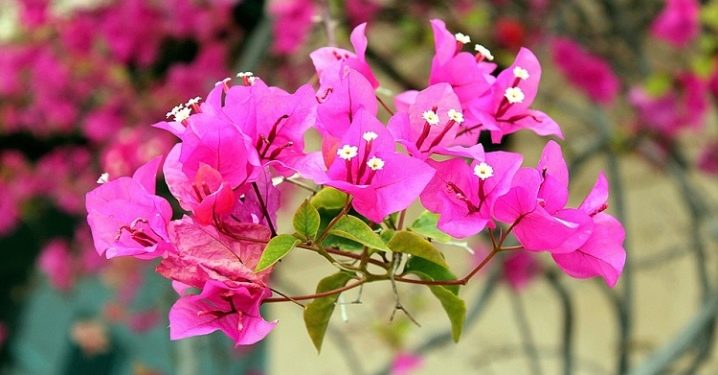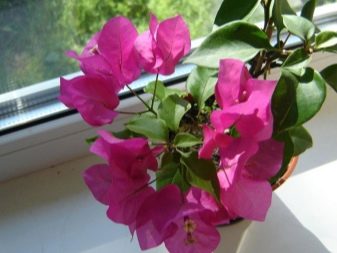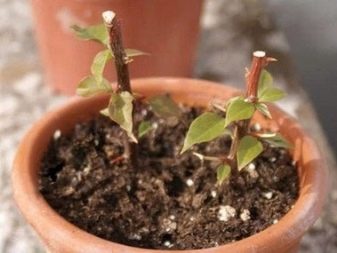Bougainvillea: features, types and plant cultivation

Bougainvillea is one of the most beautiful flowering plants and pleases those around with bright bracts. The plant is well suited for home breeding and can bring even the most dull landscape to life.


Peculiarities
Bougainvillea (Latin Bougainvillea) was discovered and described by the French botanist Philibert Commerson, who, while on an expedition around the world, discovered it in the forests of southern Brazil. The flower owes its name to the leader of this campaign, Louis Antoine de Bougainville, whose honor was named. The discovery of the species dates back to 1768, and since 1861 the plant has been cultivated in Europe, Asia and Australia.
Bougainvillea was especially fond of the inhabitants of France and Italy, and she herself perfectly perceived the climate of these countries. Tourists and travelers every time admire the climbing plants, literally winding at home, and are amazed at the variety of colors and shapes. The flower is planted as a hedge, used to form bonsai and is often used in landscape design.



On the territory of our country, culture is not planted in open ground, which is associated with seasonal temperature fluctuations and a high probability of frost. Domestic flower growers grow the beauty in winter gardens, and in the summer they take it outside and use it to decorate courtyards and public areas.
Bougainvillea belongs to the Niktaginov family and is an evergreen climbing shrub, reaching a height of 5 m in its natural environment. The leaves are alternately arranged and even solid edges, and the flowers are rather inexpressive and little noticeable. Wide and bright bracts, painted in purple, bright pink, violet, yellow and pale white colors, give a high decorative effect to the plant.
The plant is well suited for indoor and greenhouse cultivation and is often used as a bole.



Views
The bougainvillea genus includes 18 species, but only four are used for decorative breeding. it Bougainvillea glabra (naked or smooth bougainvillea), Bougainvillea spectabilis (wonderful bougainvillea), Bougainvillea Buttiana (Buttian bougainvillea) and Bougainvillea Peruviana (Peruvian bougainvillea).
- Bougainvillea nude is a very popular indoor species due to its compact size and good flexibility in crown formation. The flower grows no higher than 5 m, has smooth beautiful leaves and is the ancestor of many modern varieties.
- Bougainvillea is wonderful (beautiful) is a taller species. With good care and creating optimal conditions, the height of adults can reach 15 m. The species has velvet leaves pleasant to the touch, has a large palette of colors and is often used for vertical gardening of facades.
- Bougainvillea Peruvian, unlike previous species, it is only gaining popularity and, until recently, was used more for breeding work than for indoor breeding. All plants of the species are distinguished by long and abundant flowering and good survival rate. However, the flower does not bush very well, which is why it has to be stimulated with frequent pruning.
- Bougainvillea Buttian is a hybrid species that appeared as a result of crossing naked bougainvillea and Peruvian. As a result, the hybrid took the best qualities from the parents and is characterized by high decorative properties and long flowering.


Such a modest number of cultivated species is quite enough to show all the diversity of the genus. This is due to the large number of varieties and hybrids that amaze the imagination in a variety of shapes and colors. Below are some of the most popular varieties, the reviews of which are most common.
- Double Pink. The plant has pink double bracts with a yellow-green center, which look very elegant and are in perfect harmony with the juicy green of the leaves.
- Limberlost Beauty. A distinctive feature of the variety is the delicate white double bracts with a green center. In the sun, they turn pinkish and look very unusual.
- Vera Deep Purple. Representatives of this variety are distinguished by large bracts of bright crimson color, which are effectively combined with dark green large foliage.
- Orange Ice. The variety is characterized by interesting orange bracts, which at the end of flowering acquire bright pink tones. The leaves of the plant have a variegated color and are presented in three shades.
- Sacura. This variety is compact and great for indoor breeding. The flower grows very well and has pale pink bracts that turn pure white with pink veins at the end of the season.



Conditions of detention
In order for bougainvillea to develop correctly and delight others with its gorgeous color, it is necessary to pay special attention to creating comfortable conditions for it.
Location selection and lighting
The best place for bougainvillea will be an insulated loggia or a winter garden. Growing a flower on window sills is also possible, but in this case you will have to constantly limit its growth and regularly prune it. For the summer, if there is such an opportunity, it is advisable to move the plant to the street. This is usually done in late spring-early summer, when the threat of late frosts has already passed, and daytime outdoor temperatures are equal to room temperatures.
To accustom the plant to the street should be gradually, exposing for several hours and protecting with lutrasil from wind and direct sunlight. Every day, the duration of the flower's stay on the street is increased, and after 2-3 weeks it is completely transferred to the street content.


If this requirement is neglected and the indoor plant is exposed to the street without adaptation, then the flower will quickly shed its foliage and lose its decorative effect.
After the bougainvillea gets used to the street, you can put it in a sunny place protected from drafts and leave it until autumn. It is advisable not to shade the bush with other plants and not move it from place to place. This is especially true for the flowering time: it is highly undesirable to turn or move the plant during this period. The flower needs 6 hours of exposure to direct ultraviolet rays and even minor shading is very painful.


Temperature and humidity
Bougainvillea belongs to very thermophilic crops and does not tolerate cold. The optimum temperature for indoor growing is considered to be above 23 degrees in the summer, and at least 15 in the winter. From October to March, the flower should be in a dormant state necessary for the plant to rest and prepare it for the new growing season.
If high room temperatures persist in winter, there is a risk that the plant will not "fall asleep". This will negatively affect its further development and can cause very poor flowering, and in some cases its complete absence. Therefore, the organization of dormancy is an important condition for the normal growth and development of a flower.


In order to send the plant for wintering, from the beginning of October, watering is reduced and the flower is moved to a cool, but at the same time quite bright place. The substrate temperature should not drop below 5 degrees, otherwise the roots will freeze and the bougainvillea will die. During the dormant period, the plant usually sheds its foliage and rests. At the end of February, the flower is returned to a warm room and gradually brought out of its dormant state.
As for the humidity of the air, the bush feels great at room temperature of 50-60%, which is due to the relatively dry and sunny climate in the homeland of the plant. On summer days, bougainvillea can be sprayed, and trying to do this so that drops of water do not fall on the bracts. With prolonged or long-term drizzling rains, the flower is protected from an excess of moisture, and ideally, it is brought into the house.
In the autumn and winter periods, spraying is reduced by several times or stopped altogether.


How to care?
Bougainvillea is considered a fairly unpretentious plant and needs the most common care, including watering, feeding and replanting.
Watering
During the summer months, the plant requires abundant and timely watering. You should focus, first of all, on the state of the substrate and in no case should the earthen coma dry out. The air temperature must also be taken into account, and when it decreases, watering should be reduced. This is due to the fact that the plant does not tolerate cold dampness and, being in such conditions, can lose foliage. Half an hour after watering, excess moisture from the pallets must be drained, otherwise the roots may rot.
In winter, when bougainvillea is dormant, the frequency of watering is significantly reduced, while trying to prevent the tips of the shoots from drying out and weakening the turgor. By the end of February, the intensity of moisture is gradually increased, and after the flower awakens, they switch to summer mode.
Sometimes an increase in watering and the bright winter sun provokes the bougainvillea to bloom early, and beautiful bracts appear on the bare branches. In this case, you do not need to worry, the bush will quickly fade and continue to develop according to seasonality.

Transfer
When grown indoors in pots, bougainvillea needs regular replanting: it quickly grows the root system and the capacity becomes small for it. At the same time, the roots are in a constrained state, and the flower slows down its growth. The new pot should be 2-3 cm wider than the previous one and must have drainage holes.
Bougainvillea transplant soil is purchased in a store or prepared independently. To do this, garden soil or turf is mixed with leaf humus and river sand in a ratio of 2: 2: 1, and a little vermiculite or charcoal is added. A layer of expanded clay is laid on the bottom of the pot and a little substrate is poured on top.


Then, using the transfer method, they transfer the plant to a new pot, trying to preserve the earthen lump as much as possible, and fill up the soil. The procedure is performed in early spring, immediately after the flower wakes up from hibernation. If the bougainvillea feels great and does not show signs of depression, then you do not need to touch it. In this case, the transplant can be postponed for another year, carefully replacing the top layer of the earth with a new one. So, young, actively growing specimens up to the age of 3-4 years are transplanted every year, and more mature plants - every 2-3 years.
After transplanting, bougainvillea is watered abundantly, the green mass is sprayed with "Epin" or "Zircon" and removed to a bright place. If a purchased nutrient substrate was used to transplant the bush, then no additional fertilizing should be made for 2-3 months. This is due to the fact that the soil already contains the required amount of micro- and macroelements, and saturation with them can lead to burns of the roots and death of the flower.


Top dressing
They feed bougainvillea throughout the growing season, using mineral complex fertilizers, for example, Agricole, and during the period of active growth - mullein solution or humus. When using ready-made preparations, preference is given to formulations with a low nitrogen content., since its overabundance provokes an active increase in green mass, as a result of which flowering can become impoverished.
Since the second half of summer, to improve flowering, solutions of preparations with a high content of phosphorus and potassium have been used, diluting them in half the concentration of that indicated on the package.


Pruning and shaping the crown
Prune bougainvillea regularly. Firstly, this procedure promotes the emergence of new shoots and plant renewal. And secondly, a well-formed crown significantly increases the decorative properties of the flower and makes it very attractive. Weak, damaged and dry shoots are cut first, and then strong healthy annual stems are cut in half.
The plant is pruned either in early spring, before it begins to actively grow and bloom, or in the middle of summer, between the first and second waves of flowering, not forgetting to pinch the faded shoots, leaving 4-6 buds on them.
- When forming bonsai lignified shoots are not touched and used as a stem, and when growing a hedge, the flower is left as a vine and fixed on supports. The most suitable varieties for bonsai are Mini Thai variegate, Pink Clouster and Mini Thai, and Double Red terry hybrid.
- In addition to vertical landscaping and bonsai, bougainvillea is often given an ampelous shape. To do this, the pot with the plant is placed in a hanging planter, and the hanging shoots are cut to the desired length.
- When forming volumetric figures from bougainvillea, for example, baskets or a ball, a wire is placed around the flower, bent in the desired shape. The growing branches are gradually directed along it, while fixing the green shoots.


Reproduction
For propagation of bougainvillea, seeds, cuttings and lateral layers are used.
Seeds
The seed method is used very rarely, which is associated with the risk of loss of parental traits and plant degeneration. First, the seeds are soaked in "Zircon" or "Epin", and then spread on a substrate made of sand and peat, taken in equal parts. Before planting, the soil is calcined in an oven at a temperature of 220 degrees for 15 minutes. Then the planting is sprayed from a spray bottle and covered with film or glass. Ideally, the container should be equipped with a bottom heater that maintains the substrate temperature at 27 degrees.
Periodically, the soil is moistened, and the plant is ventilated. After the first shoots appear, which usually occurs after 2 months, the glass is removed and the seedlings are grown in the usual way. After 2 leaves appear on young sprouts, they are dived into different containers and transferred to a general care regimen.


Cuttings
In order to propagate a flower using a cutting, a part of the shoot, which has 1-2 buds, is cut from the plant. In this case, the lower cut is made oblique and performed 2 cm below the kidney, and the upper cut is straight and 1 cm above it. Then the cutting is slightly dried and treated with "Kornevin".
The planting is carried out into a substrate of leaf humus and quartz sand, taken in a ratio of 2: 1. The stalk is buried 3-5 cm, moistened and covered with a glass jar. Periodically, the soil is sprayed, and the sprout is aired daily.
Rooting usually occurs after 2-3 months, after which the jar is removed.


Side layering
For propagation of bougainvillea, a green lateral shoot is taken by layering, cut it a little and fix it with an incised place in the soil. A small layer of soil is poured on top and periodically moistened. After the roots appear, which happens after 1.5 months, the cuttings are cut off from the mother plant and transplanted into a separate container.


Diseases and pests
Bougainvillea is very rarely sick, and many developmental abnormalities are more likely to be associated with care errors than with illness. For example, if a flower turns yellow and falls off, then the reason is most likely an excess of moisture. And if the leaves begin to dry at the petiole and it is easy to move away, then here, on the contrary, the plant does not have enough watering. Falling green leaves indicate a lack of nutrition or sudden changes in temperature.
Of the pests, bougainvillea is often attacked by spider mites, mealybugs, scale insects and aphids. In this case, removing the affected leaves, washing the flower with a solution of laundry soap and mandatory treatment with Aktellik or Fitoverm will help.
When the plant is damaged by powdery mildew, spraying with "Fitosporin" helps.


In the next video, you will find the secrets of growing bougainvillea.

























Can you please tell me why bougainvillea leaves curl?
The comment was sent successfully.